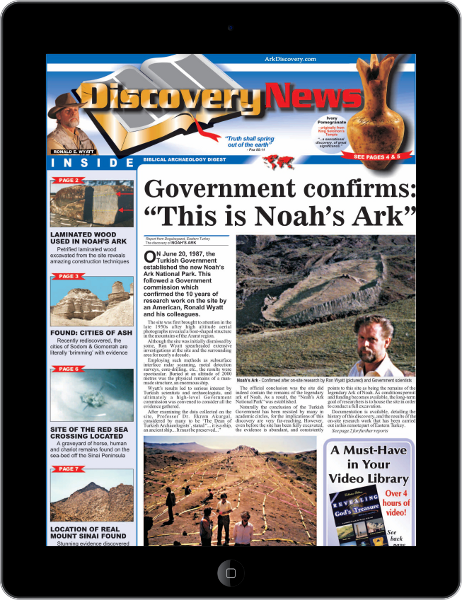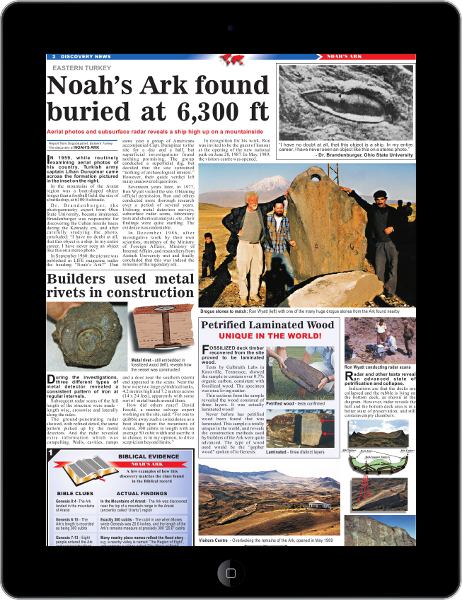

1) Was there enough water for a worldwide flood?
A valid comment perhaps, so let’s consider for starters, it’s a fact that about 70% of our planet’s surface area is sea….and there’s 18 times more water below sea level than there is dry land above it.
It is well known also that most of the earth’s mountains are of a “recent” formation. If sea beds can rise and continents sink, there would indeed be sufficient water for a worldwide flood. This much is certain. It was no gentle rising of water. The forces which triggered this disaster were probably so powerful as to have tipped the earth on its axis. The result would had been tremendous stress within the earth’s crust. Cracks opened up – and fire water burst forth.
In the explosion of the earth’s crust, volcanic ash and hot water was blown high into the sky. The protective vapor canopy above the atmosphere began to collapse upon the earth. It poured down in such volume and force, that the results were disastrous. Tidal waves of enormous height swept from pole-to-pole. Land masses and seas were churned up together.
Did you know that on every continent and in numerous places are vast “fossil graveyards” where creatures have been swept to their death in their millions?
In some places, thousands of elephants, penguins, palm trees, fish and plants are found mixed up together – arctic and tropical creatures, animals of the deep sea and the land, of the highlands and lowlands – are today found mixed together, over thousands of square miles, in single vast burials. In other locations, even dinosaurs, coal and human relics are jumbled up together. LAND creatures and creatures of the DEEP SEA – ALL MIXED AND BURIED TOGETHER in a completely un-natural way! Predators are found today, frozen in mid-motion, fossilized in the act of swallowing their prey. Complete islands and mountains hundreds of feet high, from the Arctic Circle to topical Burma, are composed entirely of animal and tree remains, swept together violently.
We are not told about this, are we? Here is something crucial, that is not disclosed to the public:
Tree trunks penetrate through several seams of coal (each layer, according to popular theory, millions of years old). Did these trees stand on end for millions of years whilst awaiting burial? Surely the event was sudden and rapid. And these layers – coal seams – were deposited rapidly by moving water. Yes, water covered the whole earth. And the action was violent.
2) What evidence is there that this is the remains of Noah’s Ark?
The following is general summary of the evidence which has been found at this site. We shall be going in more detail on some of the points, which are deemed important. The gradual accumulation of evidence over some 34 visits from various peoples and organizations, has included these finds:
- – Ship’s anchor stones in the vicinity
- – Metal nowhere in the ground around the boat-shape, but only inside the formation.
- – Inside, an organized pattern of iron at regular intervals
- – Radar evidence of man-made structure (walls, cavities, tank shapes, passage ways, side door way, ramp, etc)
- – Regular vertical structure around the sides – crossed by horizontal formation, to form a “lattice work”
- – Petrified, laminated wood
- – Fossilized rivets containing a sophisticated alloy 4-foot-long metal rods
- – Iron angle bracket
- – Slag (waste product) from some type of metal production, coming out of the boat-shape from a location which suggests it could have been ballast
- – The formation is the correct size (both length and breadth) to be Noah’s Ark
- – It is in the correct location (the Biblical “mountains” – [plural] – of Ararat).
THE ANCHOR STONES:
On the tops of hills in the area Ron Wyatt had found some big stone objects, with holes through them. These were similar to ancient sea anchors found on the sea bed near ship wrecks around the world. These were essential equipment for ancient shipping. They were called “DROGUE STONES”.
With their flat surface area, they created a drag, in turbulent waters, to prevent a ship slipping sideways against a wave. In calmer waters, they hung deep, sounding for the bottom. They could have been manipulated also to direct a vessel around an obstruction. These “drogue stones” in the Turkish mountains were more or less in a curving line leading to the boat shaped object. They were of the size that would have been required by a ship of the Ark’s dimensions. Each carried a hole near the top, possibly for a cable or rope.
3) Aren’t the Anchor stones too far away from the, so-called, Ark site?
On the slopes of the Ararat mountains, at intervals, more less in a straight line with the Ark site, are 13 GIANT SEA ANCHORS! The stones appear to lie near the same spot as when they released from the Ark.
When Mel Fisher found the 1622 wreck of “Atocha” in the waters off Florida, its anchors were 16 miles (25km) away from the primary wreck site. The Ark’s anchor stones lie in what would have been a protective anchorage and the present wreck site is found downstream from the anchor stones.
The Ark’s entry into this area is clearly defined by the positions of the stones. As the Ark came progressively into shallower water, it is probable that these stones were progressively cut-off.
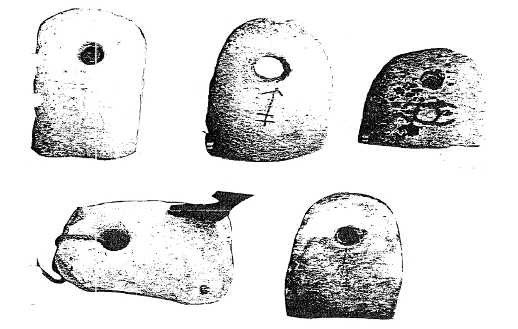

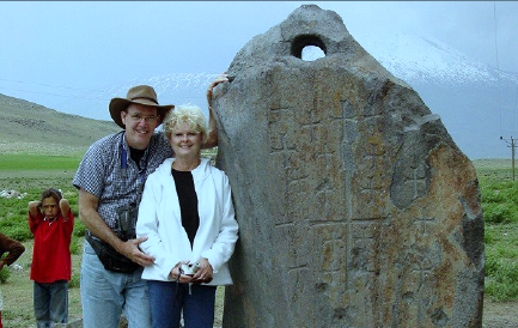
4) The Bible doesn’t say Noah used anchor stones?
The Bible account of the Great Flood is brief. Since it does not detail Noah’s activities on board, it is faulty logic to assume from silence that Noah’s crew were idle. In every Biblical act deliverance, divine & human co-operation was required.
Among the 600 worldwide traditions of the Deluge, several mention “the stones.” Sanskrit and Sumerian accounts speak of these (drogue) stones. In the Babylonian accounts, those on board severed cables and handling lines. The Epic of Gilgamesh says; “For there is no crossing death’s waters without the stone things.”
Today we would say, “there is no driving a car without the brakes things.” Actually, the historian Herodotus called the ancient anchor stones (drogue stones) braking stones. If they didn’t have something like anchors, then what would they use to bring the vessel to a halt?
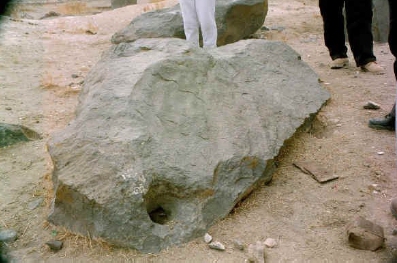

5) How could the Ark contain iron or metal fittings, studs or rivets before the iron age?
If Noah had built a ship of the size specified in the Bible, it made perfect sense to expect that he used metal in attaching the timbers together. After all, in Genesis, we learn that metal production was a science long before the time of the flood;
“And Zillah, she also bare Tubal Cain, an instructor of every artificer in brass and iron..” Genesis 4:22
Long before the so-called “Iron Age,” human technology was incredible advanced.
6) If Noah used metal, then where are all the early metal objects of civilizations that followed?
One of the most exciting discoveries at the site of Noah’s Ark was the large amount of metal found in the remains of the vessel. A few miles from the site of the Ark is the Araxes river – across the river is the site of Medzamor. Here, within a few miles of Noah’s home, is what is termed “one of”, if not “THE” oldest metallurgical factory site in the world! Analyses of copper found there showed 14 different alloys, including tin, lead, antimony and zinc.
The centre was sophisticated. Clay pipes were found inserted into the furnaces, as well as phosphorus briquettes, used in the smelting of cassiterite to obtain tin. Here vases and objects made of all the common metals have been found. Fourteen varieties of bronze were smelted for different purposes. Medzamor also produced metallic paints, ceramics and glass. And the Medzamor craftsmen wore mouth-fillers and gloves, as do modern craftsmen. The factory is believed to have had more than 200 furnaces.
Medzamor was industrial centre of this early post, Flood period. Ore was brought in and the finished products distributed to all other areas. Several pairs of tweezers have been unearthed here. The steel used in tweezers was of an exceptionally high grade. The tweezers were like eyebrow tweezers, that enable chemists and watchmakers to handle micro-objects which they cannot manipulate by hand.
Archaeological sites are excavated to discover the sequence of materials; those found directly above virgin soil with nothing below them represent the earliest occupation level. At Medzamor, the earliest phase yielded bronze slag. This discovery continues to puzzle archaeologists. Why? Because it has been assumed (from the evolutionary theory) that man progressed very slowly through various stages of knowledge. Firstly the discovery of fire, then the invention of the wheel, then cultivating crops and domesticating animals, and then, much later, the knowledge of metals and metallurgy.
But here is evidence that man appeared on the scene from the start with tremendous technological knowledge, producing an alloy (bronze) which requires tin and sometimes zinc for increased hardness.
French journalist Jean Vidal reported in ‘Science et vie’ July 1969:
“Medzamor was founded by the wise men of earlier civilizations. They possessed knowledge they had acquired during a remote age unknown to us that deserves to be called scientific and industrial.”
How few people today have heard of this early-post flood complex! Think about it, it has taken our civilization 600 years to develop to what it is today. From gunpowder and printing to nuclear physics and computers. If this is where we are today after 600 years, just imagine how far the people in Noahs days could had advanced in the same length of time – the people who were the originators of civilization!
7) Have any of the metal fittings, studs or rivets been tested to determine if they are are actually iron?
Please see the lab report from Teledyne-Allvac Lab, based in America. This lab report was sent to Richard Rives, a strong supporter of the Ark findings. This company specializes in titanium and offered to lab analyses, which was also video-taped.
The metallurgy lab did some careful analyses on the specimen, taking samples from what appeared to be the washer around the head of the rivet, and then a sample just 1cm away from the washer, from the area which would had been wood. In the final report, the chemist found it worthy to note in his report:
“It is interesting to note that location 1 (presumably fossilized timber members) was found to contain much higher carbon (1.9%) than location 2 (presumably fossilized metal.)”
The Lab ran four analyses. One sample was taken of the actual metal rivet. This section was tested twice and showed carbon of .14% and .13%. Then the sample taken from a mere 1cm away from the metal rivet (sample taken from around the metal rivet), showed carbon content of 1.88% and 1.97% in the two test done. This shows that within a cm, we have an area that contains almost 15 times more carbon.
Whether people want to admit this or not, this is positive evidence as you can get that this fossilized object – whatever it is, even if a person wants to reject it being a rivet – this is evidence that it is two distinct structures. One with minute amounts of carbon in it, while right next to it, an object 15 times more carbon in it – enough to have once been living matter.
More test results will be coming soon!


Pictures 1 & 2 show fossilized rivets. Although fossilized it was revealed through lab tests to contain a very sophisticated alloy of metals. Picture 3 shows a rivet from the side. The washer can be seen around the head of the rivet. Pictures 4 & 5, these rivets were detected with metal detectors in 1984 and photographed in a matrix – without disturbing the outer materials. Here, can be seen a group of three – on top of the other.
The combined analyses of the fossilized rivet provide more than ample evidence that it was composed of an alloy which contained aluminium, iron and titanium; an alloy which would be extremely strong, lightweight and resistant to the corrosion of the sea waters. Is all of this coincidence?
“The major alloying elements that are added to titanium are aluminium, vanadium, molybdenum, manganese, iron and chromium.” Encyclopedia Britannica vol.18, p456.
All three analyses of the rivet show iron, aluminium, and manganese, vanadium and chromium. Perhaps one or two of these could be accepted as “coincidence,” but the entire picture is one that cannot be denied. Thus the composition of the object is consistent with that of a sophisticated man-made alloy.
8) Other people have said that the rivet found is merely a rock, due to the high volume of silica. Could this be true?
It should be noted that the rivets found have all been FOSSILIZED! One who works in a natural science lab would know that the analysis of any fossilized material (silicon replaced) is superficially similar to the analysis of ore bearing stone. We must also remember that the Ark was covered by a disintegrated lava (from magma) mud slide, and became gradually petrified with molecules of the substance in the earth ABOVE the Ark, which were minerals.
Encyclopedia Britannica, 1985 edition, vol 19, page 506 (under “volcanoes”) states: “Magma consists of a molten-silicate mass within the earth, of various composition.”
In fact, all petrified objects contain a great deal of silica, due simply to its abundance of soil . Furthermore, common-sense must be allowed a place in this. Appearance of the original artifact (morphology) is preserved and can be identified by honest observers.
BALLAST
Ballast material has also been found on this Ark. What is ballast, you may ask? Ballast is an absolute necessity for any ship. It is any material of weight which is placed in the hull for purposes of stabilizing a ship. For more information on this subject, look up the topic of ship building. You will find that it is not something that a ship “may or may not” have – it is a necessity! The evidence at the Ark shows that builders of the Ark used a most ingenious substance for their ballast.
On one analysis of the ballast material it contained; 84.14% manganese, 0.12% titanium, no iron, 7.91% silicon, and 1.12% aluminium, among other constitutes. The ballast materials, under electron microscope, display the appearance of slag and can therefore be identified with confidence.
9) What have the radar & metal detector scans proved?
What has survived!…The vessel is in a state of petrification and collapse. We say that with regret!
One may see a parallel with the remains of other ancient ships that have been found – for example, those of the Sutton Hoo Viking Burial ship, discovered in 1939. In this case, the wood had completely rotted away. However, as the excavators carefully unearthed the treasures, they discovered corroded iron clench nails still in place.
“As they continued clearing from one end, Mr.Brown was careful to see that the nails, which now began to appear in a regular pattern, remained in position. As the earth was removed bit by bit, the forward part of the ship emerged in rough outline…..until, moving toward the center, they cleared to the eleventh frame, or rib, and reached what they believed was a burial chamber. The outline of the huge ship was perfect. Every vestige of wood had rotted away, but what remained was a perfect impression of the ships hull, which had been in the sand for centuries. The earth was stained from the wood and the rusted iron clench nails that had once held the ship together exactly in place…” -The Treasure of Sutton Hoo, Bernice Grohskopf; Atheneum
This demonstrated that even when the wooden structure was completely rotted away, its presence could be detected by the colouration and stains left behind.



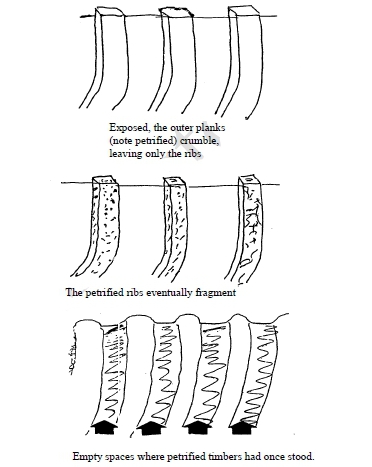
Noah’s Ark is the oldest man-made structure on earth. Its condition is EXACTLY how it should be for its age. Only the internal structure could have survived the weathering. The metal detector scans showed a very distinct organized pattern of metal beneath the surface, consistent with the shape of the ship. These scans were done numerous times, using three separate types of metal detectors, all which confirmed the same results. The sub-surface interface radar scans revealed visual evidence of organized structure encapsulated within the boat shape, structures that were positively identified by the radar specialists as being man-made.
Ron Wyatt and his team used the SIR3 subsurface radar scanner. The radar was used in sweeps in three directions. Longitudinal, transverse and lateral, along the sides. This triangulated scanning was used throughout the whole length of the object. From the radar readings to the eventual computer images, Ron used the same technique which the US government uses when they see s satellite image and they don’t know what it is. It is called a ground Truth Unit, which verifies beyond doubt. What is more, the results are not enhanced by the computer. They comprise raw data from the scan. After many, many radar scans from 1986 – 1987, a more complete picture of the ancient ship has emerged.
The bottom deck is the best preserved deck. It contains a large number of small rooms (cages), both along each outside wall and also down the middle, with walkways in between. Also, the size of the cages indicates that the animals were small – probably just weaned. That would make sense. If you wanted to preserve an oak tree, you would not take a fully grown tree on board, but simply a acorn. A ramp system leads into the ship door on the lower right side of the prow (front end).
The middle deck contained an open area extending through the middle of it. What appear to be doubled-stacked cubicles extend along each side of this opening. Four spacious “rooms” lie on each end of the deck. The structure of the upper deck was too damaged to reconstruct. All that could be known was where it began and ended.
In summary, the radar scans shows that the decks have collapsed. However, the second deck is discernable as to “floor plan”to a small degree and the lower deck is quite discernable. The “bulk-heads” were seen, as well as the deck support timbers.
It appears that a large part of the exterior has been assimilated into the closing mud shell and exists as a patten of inclusions rather than physical items. Even if no actual remains had ever been found, the colouration and impression left in the mud would be enough evidence.





10) Is it true that before using the Radar Scans and metal detectors, Ron used a “crank” device to obtain the iron patterns over the boat-shaped object? And that the molecular frequency generator is nothing but a “divining rod”?
This instrument is not a “divining rod” but works on very solid scientific principles. Many scientists, archaeologists, engineers, etc have in the past used it. In fact the molecular frequency generator, has also been used, in the past, to help the Police department in America, locate the body of a drowned boy in a lake in Nashville, TN. It has been under attack from critics claiming it is like a “divining rod”, simply because the rods used are similar in appearance. In 1988, Ray Brubaker, of God’s News Behind the News in St.Petersburg, Florida, asked an electrical engineer to research Ron Wyatt claims. This independent, non-biased research on the part of Terry Johnson of Tampa, FL., included research on the molecular frequency generator. Please read the following report:
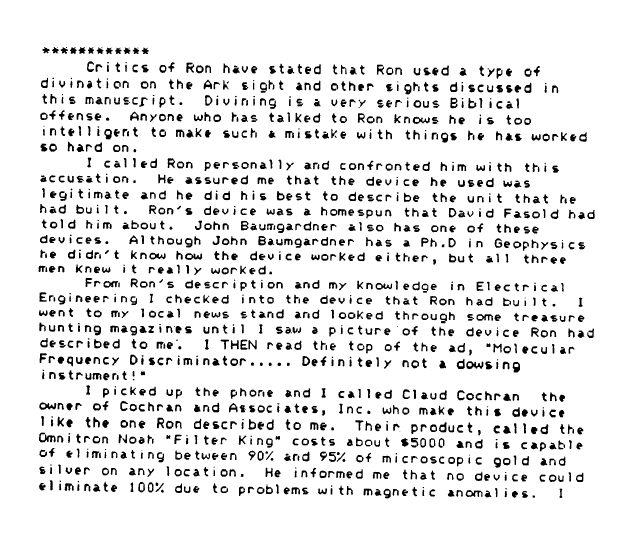
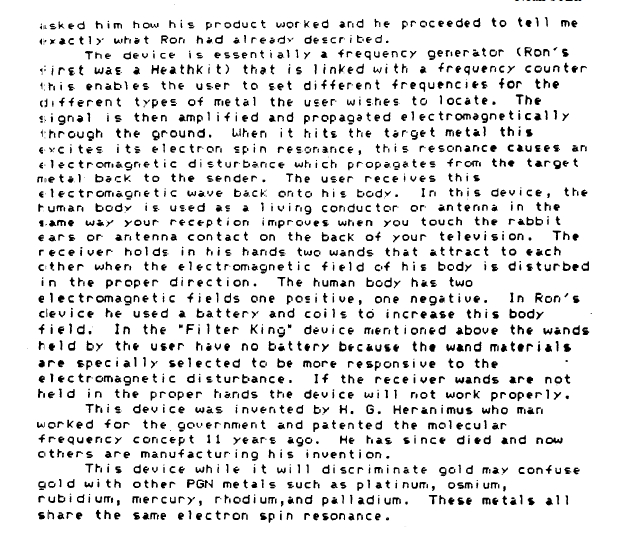

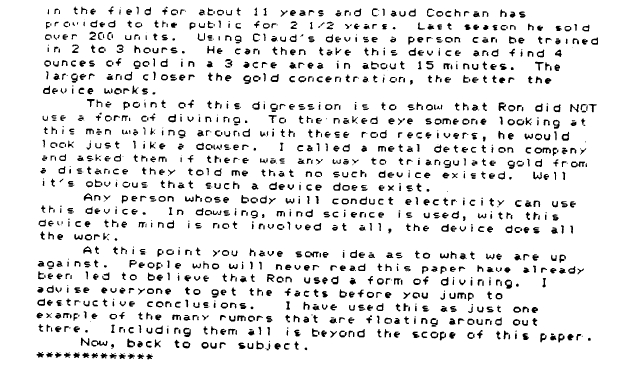
Are the readings based entirely on that molecular frequency generator?…Ron Wyatt & his team used THREE types of metal detector:
1. Pulse induction
2. Ferromagnetic
3. Molecular frequency generator
The location of metal on the site with the molecular frequency generator was identical to those located by ferromagnetic and pulse induction detectors, as well as the subsurface interface radar. So, if you want to eliminate the molecular frequency generator scans, the RESULTS ARE STILL THE SAME! If you completely discount the use of MFG, the evidence of the metal lines is still present and verified by the conventional metal detectors. The point is, that two other types of metal detector, as well as two sub-surface radar systems independently revealed the same features in the same locations as indicated by the molecular frequency generator.



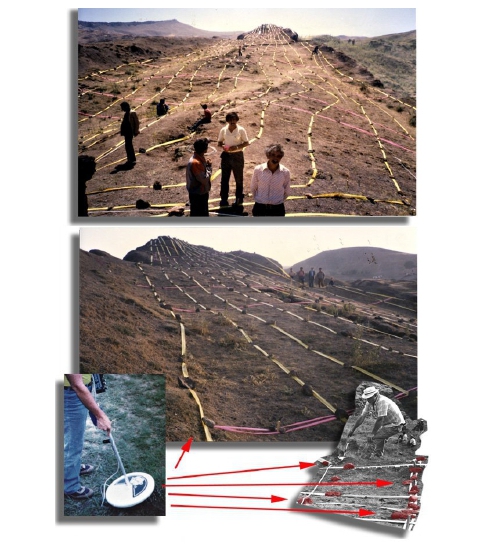

11) Has any petrified wood been tested?
Firstly, it is worthy to note the Aramaic root word for the Hebrew word translated “gopher wood” means laminated wood (this is when layers of wooden boards are glued together one upon another to provide extra strength).
Plywood in ancient Egypt
Jean-Phillippe Lauer, in his book Saggara: The Royal Cemetery of Memphis, makes this statement concerning the knowledge and use of laminated “plywood” in very early Egypt. “…..within the remains of a coffin whose sides were made of six thin superimposed layers of wood with the grain alternating as in modern ply wood.” (P.99 . Pub. Charles Scribner’s Sons, New York) As we have stated earlier, an actual specimen from Noah’s Ark, presumably a piece of deck board is made of laminated (plywood). The use of the same method by the early Egyptians proves that this knowledge was available in the early years of Ancient Egypt, passed along undoubtedly through Noah’s offspring as they begun to settle throughout the world. It would probably stagger the imagination if we knew how much technology was lost by man after the Flood.
In October 1984, when the Turks sent their own team of archaeologists to the site, their expedition yielded very positive results. Apart from four-feet long metal spikes and other metal objects, they recovered PETRIFIED WOOD. Then, on June 20th, 1987, Ron Wyatt had a day that he would never forget. A great discovery was about to occur. Governor Sevket Ekinci of the Turkish province of Agri issued instructions that the American crew was to stay upon the hill. They were not to film the event – it was his. He allowed some journalists, a Turkish cameraman, some members of the military, and other dignitaries only, to witness the next events. Setting up the radar, Ron made several passes. Explaining the printout to the group with one of his liaisons, Mine Unler, translating, he noted that one particular reading appeared to be very near the surface. The Govenor then ordered one of the soldiers to dig at the location Ron had indicated, which he did. There soon emerged what looked like a flat rock. As more dirt was removed, it could be seen that it was about 18 inches long and it was then removed.
The sample was three feet under the surface. It took 30 to 40 minutes to retrieve. All captured on film, it was obvious that it was petrified section of a hand-hewn timber! Everyone was stunned, but most of all, Ron. For nearly 10 years, he wanted to excavate but had never been allowed to retrieve anything that was not on the surface. His dream had come true! Not only was it a section of a timber, but it was almost perfectly preserved, showing the wood grain and perfect symmetry. The Governor then did something that could only be directed by a Divine Hand – he told Ron to take it to the States and have it tested. The entire event was shown throughout Turkey on TRT (Turkish Radio and Television).
The deck Timber Analysis.
When Ron brought the petrified deck timber home, he, as well as all who saw it, knew that it LOOKED like a piece of wood turned to stone (petrified). However, looks CAN be deceiving, so on Sept.16, 1987, he took the section of petrified wood that had been dug up on June 20th , to Galbraith Labs in Knoxville TN. Ron videotaped everything they did, including taking the sample from the specimen, and actual execution of the analysis. The important thing to determine was if the specimen contained organic carbon. A rock doesn’t, but petrified wood does!
Compounds of carbon can be analyzed to determine whether they are composed of matter that was non-organic, or organic, which means it can be determine if an object was organic (once living), or not, is to determine its carbon content – whether it contains organic carbon or not. To run a test for organic carbon is extremely costly and complicated, so Gail Hutchens, Vice President of Galbraith Lab, suggested another route. They would run an analysis for total carbon content. This would include both inorganic and organic . Then, they would test for inorganic. Then the two tests would be compared. By subtracting the amount of inorganic from the total amount, the amount of organic carbon could be determined.
The test results:
The result was that it contained .71% total carbon. Inorganic carbon totalled 0.0081%. It contained .7019% ORGANIC CARBON – almost 100 times more organic than inorganic.


12) Explain why there are no growth rings in the sample of petrified wood that Ron Wyatt found?
Believe it or not, even evolutionist geologists all over the world recognize that what they term “Carboniferous” wood HAS NO GROWTH RINGS.:
“….If we can imagine horse-tails enlarged from their present 3 feet to trees 60 to 100 feet high, we reproduce the Calamities of the Carboniferous forests. In their youth these trees had exactly the same structure as the horsetail; only as they grew older did they acquire wood and secondary bark that supported them and led the sap to all parts of the plant……..The giant club mosses Sigillaria and Lepidodendron, the main inhabitants of the Carboniferous forest, raised their tufts of leaves 60 to 100 feet above the ground…….To support trunks of six-foot base diameters and 60 to 100 feet height, tissues must increase in thickness from year to year. There was, as we have already said, secondary bark and wood, similar to that of modern trees but lacking the spring and winter rings which correspond to seasonal alternation of moisture and dryness. This is further proof that the Carboniferous climate was fairly uniform.” The Larousse Encyclopedia of the Earth, published by The Hamlin publishing group Limited, London-New York-Sydney-Toronto, copyrighted 1961, revised edition 1972
“The woody seed plants, such as conifers and broadleaf trees, are the most amenable to determination of age. In temperate regions, where each year’s growth brought to an end by cold or dryness, every growth period is limited by an anuual ring – a new layer of wood added to the diameter of the tree…..In most tropics, growth is more or less continuous, so that clearly defined rings are difficult to find.” Ibid, Macropaedia, Vol.10, pg.915
Temperature, light and water supply are the determining factors of growth rings. When temperatures get low enough, cell divisions ceases completely. Lack of light or absence of water can also halt growth, which would cause a tree ring to form. This accounts for the fact that the age of a tree cannot be determined by counting rings. Perhaps there was a drought, or several droughts during a season. Or perhaps, there was an “Indian summer” after an early frost. In these cases, there maybe numerous rings in a single year. But what about the Biblical flood?
The Biblical account is very short, but the information is abundant: “These are the generations of the heavens and of the earth when they were created, in the day that the LORD God made the earth and the heavens. And every plant of the field before it was in the earth, and every herb of the field before it grew: for the LORD God had not caused it to rain upon the earth, and there was not a man to till the ground. But there went up a mist from the earth, and watered the whole face of the ground.” Genesis 2:4-6
There was no rain before the Great Flood, which is one reason the coming deluge, as preached by Noah, was considered so ludicrous by the mass of people. The earth was watered by a mist which “went up” from “the earth”. This indicates a uniformly moist and temperate climate without any “seasonal” temperature changes. See also: Genesis 1:6-7 & 2nd Peter 3:5-6. The earth’s climate was totally different to how it is today! Amazingly, one 1931 geologic textbook describes these very conditions when describing the climate of one portion of the “Carboniferous” period which they termed the “Pennsylvanian.”
“Pennsylvanian Climate. Many years ago plant life of the great coal period was thought to imply a warm to tropical, very moist, uniform climate. More careful study, however, clearly points to a temperate, only relatively humid, but remarkably uniform climate. Some of the criteria favoring this latter view may be stated as follows: The great height and size of the plants together with their frequent succulent nature and spongy leaves indicate luxuriant growth in a moist, mild climate; absence of annual rings of growth shows absence of distinct change of seasons; the presence of aerial roots, by analogy with similar modern plants, implies a moist and warm climate; the nearest present-day allies of coal plants attain greatest growth in warm and humid climates; at present the accumulations of vegetable matter in bogs and marshes take place in temperate climates, where decay is not too rapid and thus suggests a similar climate for the accumulation of the coal deposits; and the remarkable distribution of almost identical plant types in Pennsylvanian rock from Arctic to tropical regions clearly show a pronounced uniformity of climate over the earth.” Elements of Geology, by William J. Miller, pub. D.Van Nostrand company, Inc, NY, 1931, p.352
Here is what it means: if the timber from the Noah’s Ark site contained growth rings, then it could not be pre-Flood wood from a boat constructed before the Great Flood. And so this could not be Noah’s Ark.

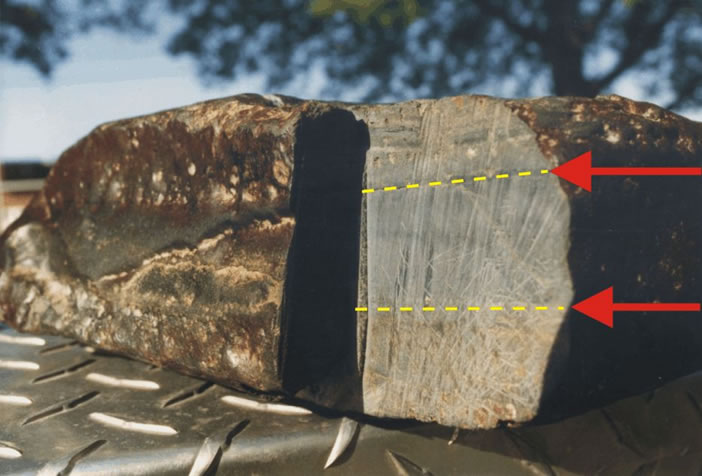
13) Hasn’t Fossilized wood been found with growth rings?
If Fossilized wood is found with growth rings, it is not pre-Flood, but post-Flood. Fossilization is the result of catastrophism, in which rapid burial occurs before the living organism can decay. Fossils were buried in abundance during the Great Flood. Since the Flood there have been many local catastrophes which resulted in fossil beds being formed. These include trees which show growth rings. Fossils do not take long to form. There have been several reports of man-made artifacts, less than 200 years old, such as hats, which were fossilized when dug up. A farmer near Hobart, Tasmania, was renewing a wooden fence known to be 60 years old. As he pulled out a post, he noticed that its base was Fossilized.
14) What other evidence, which has been verified, proves this to be Noah’s Ark?
In the summer of 1990, Mr.Jack Bouma, an engineer and architect engaged by the Dutch government in the historical restoration of windmills, found a small sample of a black tarry substance which appeared to have oozed out of a possible “deck support” on the eastern edge of the boat-shape. This was later identified as bitumen or pitch, which is specifically mentioned in the construction of the Ark, in Genesis 6:14. Positive identification of the sample was made on the basis of analysis of a concentrated extract submitted to Oil Check Pty of Sydney, NSW – and compared by them with a bitupave sample of bitumen (November 5, 1991
Sydney industrial chemist, Jeff Smith, who arranged with the Oil Check Laboratory to conduct the test, states; “The trace produced by the analysis was compared by the oil laboratory with a standard trace from asphalt or bitumen. Beyond a shadow of a doubt the substance identified as pitch.” To remove any doubt we include a photocopy of the original Fourier Transform Infra Red Spectral (F.T.I.R) analysis report from 1991.

15) The supposed Ark found in Turkey, is not the precise length of Noah’s Ark, why is this?
Modern versions of the Bible says that the Ark was 450 feet long, but the measurements of the remains in Turkey say it is 515 feet long. The original Hebrew, and the King James Version, states that Noah’s Ark was 300 cubits in length.
Revision committees who have changed the “300 cubits” of the Bible text to read “450 feet” in modern versions, are in error! They are NOT correct in the length of the cubit in regards to the Ark. They have assumed a cubit of 18 inches. They should had been calculating the length of Noah’s Ark according to the ancient 20.6 inch cubit. As stated in the Bible the cubits measurements should be calculated as it was in the Egyptian times. “Cubits according to the former measure.” 2 Chronicles 3:3 NKJV. The NIV version states; “using the cubit of the old standard.”
Moses, the compiler of the Ark account, was raised and educated in Egypt (Acts 7:22). He would undoubtedly be using the royal Egyptian cubit, which was 20.6 inches.
So using the Egyptian cubit measurement, the Ark in Turkey is EXACTLY 300 cubits in length. You can work it out yourself. 300 cubits at 20.6 inches per cubit equals 6180 inches equals 515 feet. Thus the length of the biblical Noah’s Ark and the length of the boat found in Turkey object prove to be identical.
16) The width of the Ark was 50 cubits (or 86 feet) wide. The boat found in Turkey is 138 feet wide. Why is this?
When the Ark, sliding sideways down the mountainside, hit the large outcropping of limestone, it was literally impaled on the large rock. It extended into the midsection of the ship and was the only thing which held the Ark in its present location. Since the decks had collapsed, the timbers which held the ribs in their upright position (the deck joists) were broken, and there was nothing to keep the sides from falling outward. As the Ark rotated into alignment with the direction of the lava flow (after becoming lodged on the rock), the ribs were thrown outward to some degree, around the midsection. THIS IS A SPLAYING EFFECT.
The end that made the widest swing outward suffered the most outward collapse, and this is what gives the ship its appearance of being wider than it should be. Keep in mind, however, that the ribs did not fall completely outward, but only splayed enough to give the ship a 138 foot width at the widest point, and the original width was 86 feet.
The Biblical width of 50 cubits (86 feet), was found to be the width indicated by the internal structures, such as the bulkheads which displayed this width instead of the full width of the splayed hull. The metal detector scans done in August of 1985, showed how the internal structure near the surface was literally “wrapped around the rock”, similar to a car that is wrapped around a telephone pole during an accident.

17) What other man-made evidence is there that this is Noah’s Ark?
Near the Iranian border, Ron Wyatt and his team, found the broken remains of an ancient stele which was being used in a more recent structure – as a border marker between Turkey and Iran. Almost all the pieces were still present, even though broken. The stele contained numerous inscriptions in what looked like three different forms of writing. These have since been identified:
1. It contains an inscription in cuneiform writing.
2. It contains an inscription in ancient Sumerian.
3. It contains an inscription in ancient Hurrian.
One segment of this 4000 year old inscription was particularly legible. This was the scene that depicted:
• A unique, hammock-shaped ridge.
• Then a smaller hill
• Then a mountain peak in the background
• A ship with eight faces in it
• And two ravens.
The rest of the inscription featured several animals. But the importance of the stele was that the shape of the boat was almost identical of the Ark in a 1950’s aerial photo.



Hurite inscription (c.2000BC) discovered on the ridge behind the Ark site…This identifies the ancient location of the Ark. Lets compare this with the landscape as seen today:
• Notice the hammock-topped limestone ridge?
• The smaller hill?
• The volcano rises to the right, out of the picture.
The volcano shown in the inscription, like many other volcanoes, eventually collapsed due to the release of lava. And for this reason it is no longer visible today unless you are standing on the top of the mountain ridge over 1000 feet (300 metres) higher than the present location of the Ark.
You will observe that the ship is now lower down the hill. It appears that a mud flow from the volcano eventually brought the vessel down, where it became impaled on the rock.
Also, it is a common fact that place names are a key to history. Many ancient place names in the vicinity seem to allude to the story of the great flood and its survivors. Please note the following:


18) How did Noah fit all the animals onto the Ark?
This is a common question. The truth is, the Ark of the Bible was enormous – longer than a football field, probably comprising over 32,000 tons, with sufficient internal capacity to house 494 double-decker buses! Ernst Mayr (probably the leading taxonomist in America) calculated that there are about one million animal species. Of these 60 per cent are sea animals, and 70 percent of the remainder are insects. There are less than 20, 000 species of land animals (mammals, reptiles, birds, and amphibians).
Since the average size of all the land animals is no bigger than a house cat, you could comfortably fit two of each species in just 41 per cent of the Ark space. So the question we all should be asking is, what did Noah do with all that extra space in the Ark? On the radar scans, the bottom deck of the Ark, contains a large number of small rooms (cages), both along each outside wall and also down the middle, with walkways in between. The size of the cages indicates that the animals were all small – probably just weaned. (That would make sense. If you wanted to preserve an oak tree, you wouldn’t take a full grown tree on board, but simply a acorn. So with the animals. It would had been Gods plan to let on board the small ones.) See: Genesis 6:14.
19) Some say the Ark is on Mt. Ararat. Could this be true?
The record says (Genesis 8:4): “And the ark rested…..upon the mountains of Ararat.” Notice the word “mountains” is plural, indicating a range of mountains. The Biblical Ararat was a country, not a mountain. The word occurs four times (Genesis 8:4 KJV, 2nd Kings 19:37 NKJV, Isaiah 37:38 NKJV & Jeremiah 51:27 KJV), with the meaning of country or kingdom. It was the nearest the translators could get to Urartu, a powerful kingdom in the Lake Van area of modern Turkey.
“Urartu (Armenian: Ուրարտու – Urartu, Assyrian: māt Urarṭu; Babylonian: Urashtu), corresponding to the biblical Kingdom of Ararat (Armenian: Արարատյան Թագավորություն) or Kingdom of Van (Armenian: Վանի Թագավորություն, Urartian: Biai, Biainili;) was an Iron Age kingdom centred around Lake Van in the Armenian Highlands.
Strictly speaking, Urartu is the Assyrian term for a geographical region, while “kingdom of Urartu” or “Biainili lands” are terms used in modern historiography for the Proto-Armenian (Hurro-Urartian) speaking Iron Age state that arose in that region. That a distinction should be made between the geographical and the political entity was already pointed out by König (1955). The landscape corresponds to the mountainous plateau between Asia Minor, Mesopotamia, and the Caucasus mountains, later known as the Armenian Highlands. The kingdom rose to power in the mid-9th century BC, but was conquered by Media in the early 6th century BC. The heirs of Urartu are the Armenians and their successive kingdoms.” Source Wikipedia
The Bible is simply saying that the Ark landed in the “mountains” of that kingdom. “And the ark rested…upon the mountains of Ararat.”
Ararat/Urartu (or Armenia) was a mountainous country (the Bible has it, “mountains of Ararat” – plural). We use a comparative phrase “mountains of Papua New Guinea”; “mountains of Scotland”, etc. Just as there is no such entity as Mount Scotland, nor does the Bible know any such entity as Mount Ararat.
The Ark would not have survived on Mt. Ararat
If the Ark was a reality, then so was the Flood (which destroyed the entire face of the earth), and this means that the Ark, if it survived until today, is the oldest structure on earth. Considering the fragile state of wooden homes that were built even in the last century, could we expect to find an intact Ark, or even any remains at all? Certainly not in the ever moving glaciers on Mt. Ararat, which continually flow and grind everything in their path into minute pieces. Even if an object survived in the glaciers, could it survive the incredible blasts of past eruptions, the most recent of which blew out an entire section of mountain? This volcano has experienced several eruptions, the most recent in mid 1800’s – which was very similar to the Mount St. Helens eruption which blew out an entire portion of the mountain. Go to the library and research “volcanos” and “glaciers”. Read up on Mount. St Helens. Such a volcanic upheaval would in all likelihood have destroyed the Ark, had it been there. The 3rd century BC Chaldean historian BEROSUS, the Egyptian writer ARONIMUS, and the Jewish historian JOSEPHUS, each located Noah’s Ark in the mountains (plural) of the Gordeans (kurds) in the district of Karoi – which was south of Mt. Ararat. These mountains are on the Iranian border, some 20 miles south of the actual Mount Ararat. These historians reported that the plant ARANUMIN grew prolifically at that location. This plant produces a purple flower and is covered with thorns. Its underground stems have a faint odour of violets. Today, this plant still grows there, at the very site of the Noah’s Ark remains! This plant is NOT found in the lava and ice of Greater Mount Ararat.
20) What about a number of Christian scientists who say that the Ark discovery is false?
When are the critics going to look at the facts, put aside their pride, and fairly evaluate the evidence uncovered so far at the REAL Ark? Some have searched for the Ark on Mt. Ararat while having received hundreds of thousands of dollars from donors to do so. Many of the critics demonstrate a form of desperation. Is it because they feel threatened for some reason? I know it must be humbling to admit someone else, without letters after their name, basically without outside funding, found the Ark on another mountain and without the expertise of learned men in the archaeology community. Ron Wyatt gave all the credit to GOD for locating the Ark. When he went out there in 1977, he had completed his homework by interviewing those who had been to the site in 1960, but he still didn’t know where the Ark was actually located. He and his two boys prayed before they started searching, and asked God to stall their taxi at the places where they should begin looking. Three times it stalled, much to the surprise of their driver. In each place they walked out from that spot and found something relating to the Ark, including the Ark itself, the anchor stones, and Noah’s home.
Friends, when we don’t tell the truth about the evidence, we are misleading those searching for the truth and are on dangerous ground! Our eternal destiny is at stake when we do such things. God has preserved these discoveries for those who live at the end of this world that have not had access to the truth. Today the majority of the world have grown up in false religious belief systems or evolution. God is preparing to reveal His REAL truth to mankind, including the truth of His Son. Before Christ returns to this world, a person will have to follow Him and His Law, and confess their sins in His name in order to be saved.
We challenge ANY Scientist, Christian or not, to PROVE that the real Noah’s Ark found in Turkey is false!




